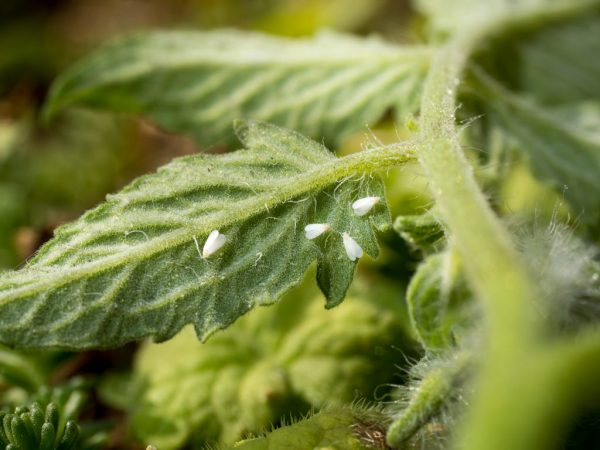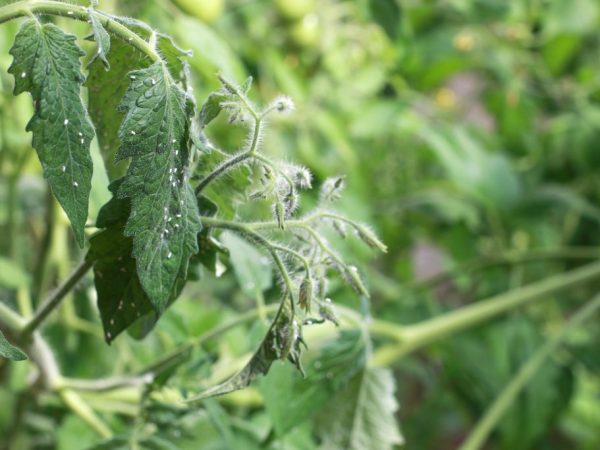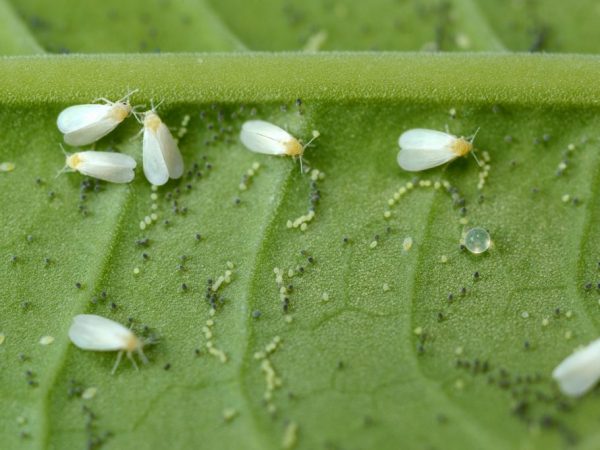Fighting Whitefly on Tomatoes
Among the pests that often cause inconvenience when growing vegetables is the whitefly on tomatoes. The small insect, which can be seen in the greenhouse, less often in the open field, quickly multiplies in the colony, harms the crop, leading to economic losses.

Fighting Whitefly on Tomatoes
What is Whitefly
This is a small insect, no more than 3 mm long, which looks like aphids in appearance. Its wings are covered with a white coating. Whitefly settles on tomato seedlings in large colonies, settling on the lower part of tomato leaves, where all the main processes of its life take place. In the same place, in the place of her residence, at the bottom of the leaf, she lays eggs, which after a while turn into larvae. In addition to tomatoes, the whitefly loves to settle on bushes of cucumbers, eggplant and other vegetables.
Whitefly harm
The whitefly, which damages tomato crops, feeds on the liquid contained in tomato leaves. Adults and larvae attached to the leaves drink the juice of tomato leaves and disrupt metabolic processes and the normal balance of nutrients in the plant. As a result of the lack of malnutrition, the crop deteriorates, tomatoes are dying.
Whitefly is capable of carrying viral infections, which become the causes of changes in the shape and color of tomato foliage that occur in tomatoes. The result of such a violation of the development of vegetable culture is the death of leaves and the cessation of growth of shoots.
Among the harm that the whitefly brings with it for tomatoes is the development of a sooty fungus on feces from insects. Initially, the remains of the whitefly's vital activity look like a bloom, colorless transparent or white, with a characteristic shine. With the appearance and reproduction of a soot fungus on this, the foci change color to dark up to black.
Pest signs
Whitefly can appear in your greenhouse from various sources, among which the main ones are:
- residues from vegetation,
- contaminated soil,
- infected seedlings, acquired in a greenhouse farm that is dysfunctional for tomato whitefly.
Signs of the processes of its vital activity can tell about the appearance of a whitefly on tomatoes:
- in the greenhouse, a white midge often fluttering over the beds with tomatoes appears, outwardly resembling a moth,
- when shaking tomato bushes, colonies appear above them, consisting of many small moths,
- When examining the lower part of tomato leaves, one can find scales of a translucent color slightly visible to the eye.
In the process of spreading in a greenhouse with whitefly tomatoes, the growth and development of a vegetable crop slows down.The leaves of tomatoes begin to turn yellow and curl, fall off over time. The sooty fungus that appeared in the process of life of the whitefly on tomatoes gradually passes from the leaves and affects the fruits, which have to be removed before they ripen. Affected vegetables must not be consumed.
Agricultural technology against whitefly
When growing tomatoes, gardeners often try to carry out a number of agrotechnical measures before encountering whitefly moths in their greenhouse.
Among the main methods that will allow you to fight and protect tomato plants from an annoying pest can be:
- compliance with the standards for planting density of tomato seedlings, allowing them to ensure their normal development in the absence of excessive crowding of bushes,
- providing the necessary ventilation in the greenhouse and maintaining the required temperature regime necessary for the normal growth of tomatoes,
- frequent loosening of the earth,
- regular feeding of tomatoes and soil with special means and the use of preparations that support the resistance of tomato bushes and strengthen the health of the vegetable crop.
Experienced growers do not advise using manure as a groundbait method. They recommend placing chicken droppings in the hole when planting tomato seedlings, which will act as a source of endurance of the tomato root system to diseases and infections.

High humidity can provoke the appearance of insects
When growing tomatoes in greenhouse conditions and outdoors, it is very important to follow the instructions for watering the plants, since excessive moisture becomes a provoking factor for the appearance of the pest and increasing the intensity of its reproduction.
Biology against the pest
Biological methods are a good alternative to fighting against whitefly and its larvae. Experienced gardeners to fight whitefly often take beneficial insects as helpers and not only do not try to remove and destroy ladybirds and lacewings, but also plant flowers in their summer cottage that attract them to plantings. The ladybug and lacewing are the main natural enemies of the whitefly.
Insects - biological enemies of whitefly moths at the pupal stage are suspended on cardboard sheets between tomato bushes.
Insects begin to parasitize on the pest, eating the whitefly, and when moving to the affected leaves, they also eat immovable larvae that have not yet matured. Biological methods of controlling whitefly on tomatoes also include introducing other parasites into a greenhouse with tomato bushes that do not harm tomatoes, but are natural enemies of whitefly moths and help to destroy it. Among the most famous, which gardeners bred, are the macrolophus bugs, wasps and encrasia.
When processing is needed
Fighting whitefly on tomatoes is recommended when no larvae were found during inspection of the planting material, but only the presence of adult moths was recorded. Such signs may indicate that the tomato crop can be saved by taking appropriate measures.
It is recommended to process tomato seedlings and bushes planted in a greenhouse or ground in the form of:
- prevention and preemption of adult whiteflies,
- treatment of the neglected process and the progressive reproduction of the pest.
An adult whitefly bloodworm poses less danger to the crop than its larvae, which are quite problematic to fight. The most appropriate time to take action against whitefly on tomatoes is when the insect larvae have not yet acquired a dense wax coating. This layer of larvae becomes an obstacle to the penetration of insecticides used in the fight against whitefly.When mature individuals emerge from the cocoons formed, the crop will not be able to ripen in the greenhouse, since new adult insects will lay eggs again, and the pest will repeat itself again. Whitefly control will not achieve the desired result and will not be effective.
Mechanical tricks
Mechanical methods of dealing with whitefly on tomatoes are not the last.
Catching moths
To catch pest moths, special traps made on an adhesive basis are used. You can make these yourself from small pieces of plywood, which are greased with petroleum jelly or rosin mixed with honey. The homemade glue trap is painted yellow, which attracts whiteflies. They place it at the level of the top of the tomato bush and shake the bush to provoke the flight of moths. The trap used with the adhered whiteflies is replaced with a new one and the capture process is repeated.
Foliage treatment
It is possible to collect adult whiteflies from tomatoes by manual mechanical processing of tomato leaves, for which you need to spray the plants with a solution containing laundry soap, and then rinse them with running water. Such manual processing will allow you to get rid of the pest and plaque masonry, wash off the present spores of the soot fungus.
Folk tricks against the moth

Whitefly can be exterminated without chemicals
Many gardeners who do not want to process their future harvest with chemicals prefer to use folk remedies and methods to destroy the whitefly on tomatoes.
Garlic
You can fight the pest with garlic tinctures, which are made from 100 grams per liter of water. The garlic solution is infused for processing for 5 days in a closed container, and then tomato bushes are sprayed with it.
Yarrow
Plants infected with whitefly can be treated with infused yarrow. It is brewed from a proportion of 80 grams per liter of boiling water. It is recommended to wipe large leaves with cotton pads, and sprinkle small ones with infusion.
Soap
Along with garlic, another folk remedy against whitefly has an effective effect - a simple laundry soap, which is rubbed on a grater and diluted in water at room temperature in a ratio of 1 to 6.
Low temperatures
Among the popular measures that have a detrimental effect on the vital activity of the pest and its larvae is a decrease in the temperature regime. For cold-tolerant tomato varieties, removing tomato bushes from the greenhouse can be an effective way to get rid of insects.
Chemical treatment against whitefly
In the fight against whitefly, chemicals are often used. When choosing means of how to get rid of whitefly on tomatoes, one should give preference to those that contain pyrethrum or pyrimifosmethyl in their composition. Quite good reviews from drugs such as Aktara, Mospilan, Pegasus and others.
Spraying
Insecticidal drugs, such as Aktara, are diluted and applied in dosage according to the instructions. The solutions obtained with actara and other insecticides are used when spraying tomato bushes affected by the pest. Chemical treatment with Aktara, Pegasus and Mospilan preparations is carried out mainly in favorable climatic conditions, preferably in cloudy, not rainy and calm weather.
In clear weather, you can spray tomato bushes by creating shade for the plants. When secondary processing tomatoes with chemicals, you need to remember that it is required to be carried out with the replacement of funds, since the pest quickly develops resistance to previously applied insecticides. The fight against whitefly on tomatoes will be more effective if different preparations and agents are used at different stages of insect development.
Fumigation
This can be done in several ways:
- some summer residents use smoke bombs lit at night to combat whitefly, containing special insecticidal preparations that will destroy larvae and adults, all that remains is to collect the upper soil layer, use them in spring and autumn, tobacco bombs can be used without harm to the crop in the greenhouse and lead to the same result as smoke.
- sulfur candles lead to the death of the pest and its larvae; after using them, it is recommended to thoroughly ventilate the greenhouse.


